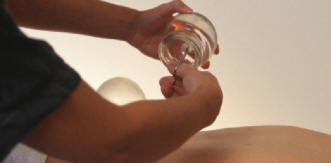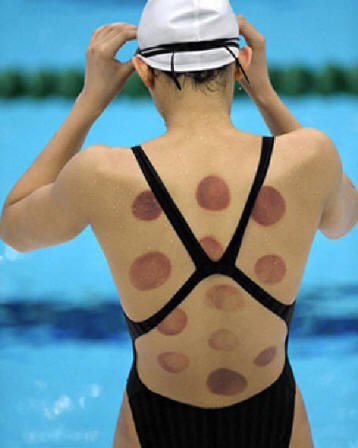CUPPING MASSAGE THERAPY
We use the art of Cupping to enhance your massage therapy experience and to make your healing energy stronger. If you enjoy the benefits of massage therapy you will love the experience of our cupping massage.
Cupping is a wonderful form of treatment aimed at stimulating the body's own healing powers. It is an ancient art of Traditional Chinese and Folk Medicines whose origins are obscure.

While cupping therapy forms a part of Traditional Chinese Medicine, it is clear that this art of treatment has appeared in folk medicines in many nations of Asia, Europe, Sicily and other Mediterranean regions.
What is Cupping?
In Cupping a cup is applied to the skin and the pressure in the cup is
reduced (either by heat or suction) in order to draw and hold skin and
superficial muscles inside the cup. Sometimes, while the suction is
active, the cup is moved, causing the skin and muscle to be pulled. This
is called gliding cupping.
Cupping is applied to certain acupuncture points as well as to parts of
the body that have been affected by pain, where the pain is deeper than
the tissues to be pulled. Cupping has greater emphasis on the back
acupuncture due to the ease with which it can be performed on the back.
Cupping is based on the meridian theory of the body. On one hand,
cupping removes any stagnation in the body and opens the meridians so
that qi can flow freely. On the other, it also helps to rejuvenate
certain meridians and organs that are not functioning at their best.
From a scientific standpoint, cupping is known to help activate the
lymphatic system, promote blood circulation, and is good for deep tissue
repair.
The Cupping Process
Glass cups are generally used for cupping, although bamboo cups are also
used. Glass cups are fitted with a valve that attaches to a small
hand-operated pump, allowing the practitioner to suck out air without
having to rely on fire to depressurize the cup first. It also gives them
greater control over the amount of suction.
In order to allow the cups to move over the skin easily, oil is used.
Oils that have been infused with extracts of medicinal herbs are
particularly useful. The cups are applied at room temperature, and there
is some friction generated with moving cups, causing a small but
significant amount of heat, especially if a warming oil is also used.
Glass cups are heated then placed on a specific area that needs treating, or on acupuncture points, creating suction. The skin and superficial muscle is sucked into the cup, counteracting stagnant energy. The cup can be left on one spot or moved around to create a “reverse massaging” effect – rather than applying pressure, the tissue is pulled upwards. In fact oil is used in the treatment to facilitate this movement.

Cups are generally left in place for ten minutes although the time can
range from five to fifteen minutes. The skin will redden due to the
congestion of blood flow. The cup is removed from the skin by pressing
the skin on one side, allowing some outside air to enter and thus
equalize the pressure. Some bruising on the skin where the rim of the
cup is to be expected.
Benefits of Cupping
If you have ever been to see an acupuncturist,
chances are that they have included a technique called cupping in your
treatment, depending on what your complaint was.
Gwyneth Paltrow has done it. So has Madonna. Even Victoria Beckham has
been known to indulge. If you have seen pictures of celebs, sporting
stars or the average person in the street with strange circular marks on
their skin, they have more than likely had a Chinese therapy known as
cupping.
Cupping is used to remove toxins and help energy move around the body.
The technique stimulates blood flow, relaxes congested muscles, treats
stiffness in the body and relieves pain.
What Can Cupping Treat?
Cupping can be used to treat sprains, injuries to
soft tissues, sore backs, hips or related pain, fluid retention,
bronchitis, asthma or congestion among other complaints. Cupping works
in a similar way to acupuncture, working as it does on the subtle energy
channels in the body to treat stagnant energy and encouraging the flow
of qi.
Increased blood flow into the cupping area allows that part of the body
to heal more quickly by bringing toxins to the surface, which can then
be released through the pores. By causing tissues to release toxins,
cupping clears energy blockages and activates the lymphatic system.
Several cups are usually placed on the body simultaneously and then left
for up to 15 minutes. This fixed-position cupping can also be combined
with “sliding” cupping in which the cups are moved to other points along
different energy channels or meridians during a treatment session. The
movement is facilitated by oil on the skin.
Other Benefits of Cupping
The therapy can be very relaxing, always a good outcome in our busy world. It can also help loosen muscles and relieve pain, improve the flow of blood and lymph, and might also help lessen the appearance of cellulite! It has also been noted that it can help clear stretch marks or scar tissue.
Cupping treatment causes no pain, but there can be a
sensation of tightness on the area that has been sucked up into the cup,
which is relieved when the cup is removed.
After cupping, it is normal to experience bruising on the skin that can
vary in color from light pink/brown to bright red or dark purple.
Practitioners see the bruising as a reflection of the degree of
stagnation or otherwise in the patient in that area. The bruising,
though, doesn’t feel painful, but it can look rather startling!
A word about Cupping Marks
The most common misunderstanding regarding one of the
most powerful and beneficial after effects of cupping, is the marks that
sometimes result.
When injuries occur deep in the muscle, bleeding often occurs causing
deep bruises. There will also be edema in the area involving the
coagulation of sticky proteins. The combining presence of these elements
usually results in stagnation of circulation to the area - resulting in
pain, dysfunction, and chronic conditions.
The vacuum formed by Cupping draws up the old non-circulating stagnant
blood and sticky fluids from the area, bringing them up to the surface
and away from the injury so that healthy free circulation can be
restored to the affected area, thus may space for oxygen, living cells
and nutrients for faster recovery.
Where there is dead, static blood, lymph, cellular debris, pathogenic
factors, and toxins present in the body, Cupping can leave marks which
indicates that the stagnation or disease has been moved from the deeper
tissue layers to the surface. Once people understand what these marks
are, and feel the results - the concerns disappear.
The color and pattern of the marks depend on the level of stagnation in
the area, and range from a bright red to dark purple, usually lasting 3
days to a week - sometimes longer depending on people. If there is no
stagnation present, there will be only a light pink mark which
disappears in a few minutes to a couple of hours. Sites where there is
old trauma or injury may require multiple cupping treatments to remove
all stagnation. You will find in follow up treatments the marks will be
visibly lighter and lighter as the pathogens are systemically removed
from the body.

Bruising is caused by impact trauma with breakage of
capillaries and a reactionary rush of fluids to the damaged location
from the tissue injury. There is no compression in correctly performed
suction cup therapy. Although it is quite common during Stationary Dry
Cupping (left static for 5 - 20 minutes - see below) to achieve dramatic
'marks' or 'discolorations', the less aggressive action of moving the
cups, minimizes the intensity and duration of the discolorations.
Often, when a condition exists within deeper structures where sufficient
pathologic factors and stagnant fluids (toxins, blood and lymph) are
dredged up during treatment, discoloration will appear on the epidermis.
As treatments cumulate and the release of stagnation and buildup has
been released, dispersed and drained – (sometimes quickly as the 2nd
treatment) no discoloration is likely to occur at all - even though each
time the cupping may have been focused on the same area, for the same
duration, and with the same amount of suction. This action is clearly
the result of having internal unwanted toxins systematically purged.
When circulation is sluggish or compromised in an injured or diseased
area of the body, insufficient oxygen gets to the cells, and there will
be a local build-up of waste products. When the skin is pressed, the
blanching that occurs is slow to fade.
Suction pulls toxins, pathogenic factors, blood poison, dead lymph and
cellular debris from deep within the tissues to the surface. These
debilitating agents are then more easily expelled from the body. The
deposits dissipate from a few hours up to several weeks, depending on
the amount of stagnation and the patients post treatment activities.
The quality of the pathogenic factors varies according to the severity
of the patient's blood stasis -- which correlates with the nature,
severity and type of condition they have.
It can appear from a light pink to a dark purple, but is usually a shade
of red. Often tiny raised bumps will appear. Sometimes a clear fluid
will be drawn to the surface.
These are all results of disease and toxins being removed from deep
within the tissues.
The more discoloration that surfaces – the greater level of stagnation
and toxicity needing to be purged from the body.


